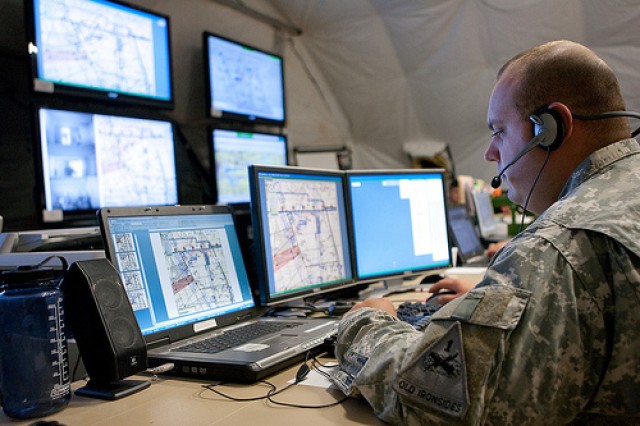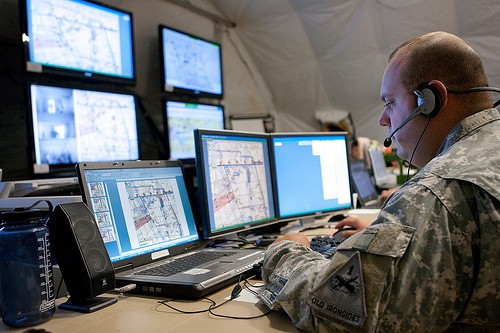ARLINGTON, Va. (Army News Service, March 7, 2011) -- The Army is preparing to conduct several Limited User Tests simultaneously at White Sands Missile Range, N.M., for key programs of record.
Dubbed the Integrated Network Baseline Evaluation, or INBE, the exercise is designed to assess the ability for a host of technologies to work in tandem as part of a larger, integrated, cohesive network, service officials said.
"This is a monumental undertaking and it requires a new level of integration and synchronization," said Col. John Wendel, PEO Integration. "The purpose is to seek efficiencies and synergies. The idea of combining events forces integration, so what we will do is synchronize the technologies into a singular network brigade formation."
The first four weeks of the exercise, slated for this coming June with the 2nd Brigade, 1st Armored Division at Fort Bliss, Texas, will include the concurrent Limited User Tests.
"If you combine the events, you are going to get better answers that cut across programs, systems and agencies. It will also make us more agile going forward," Wendel said.
The last two weeks of the INBE exercise will include an integration exercise aimed at synchronizing the systems into an integrated combat network, officials said. The idea, they said, is to facilitate a series of annual evaluations which will serve to expedite the developmental process and better inform the Army's tactical network acquisition decisions.
"By beginning to conduct exercises that look at an integrated network, the Army intends to lessen the in-field integration burden on our operational units," said Paul Mehney, spokesman for PEO Integration.
He said the exercises will provide "relevant operational environments in which to evaluate new technologies and capabilities that make up Capability Packages and Sets prior to fielding the new systems to operational units. This will ensure that the important integration work is done up front - prior to deploying systems to the field."
The Army wishes to incrementally develop network technologies best suited to serve Soldiers in combat through this process. The approach is designed to combine Army programs of record with commercial off-the-shelf solutions from industry to achieve an affordable, technologically mature tactical network able to move combat-relevant information across the force in real time using high bandwidth waveforms such as Soldier Radio Waveform and Wideband Networking Waveform, Wendel said.
"In the past we have spent years building requirements and products. Now we will conduct these evaluations every year, testing technologies from industry and programs of record to gain some economies of scale and make smarter acquisition decisions on a more frequent basis. The important part is transitioning these objective waveforms to programs of record," he said.
The systems undergoing Limited User Tests are:
- Joint Tactical Radio System, or JTRS Ground Mobile Radio - a multi-channel, vehicle-mounted software-programmable radio able to transmit voice, video, data and images using high-bandwidth waveforms such as SRW and WNW.
- JTRS Handheld Manpack Small Form Fit, or HMS -- a multi-channel, Soldier-mounted software-programmable radio able to transmit voice, video, data and images using high band-width waveforms such as SRW and WNW.
- Joint Capabilities Release, or JCR - next-generation software for Force Battle Command Brigade and Below, or FBCB2 display screens, featuring Army-Marine Corps interoperability and advanced mapping tool kits.
- Mounted Soldier System, or MSS - combat-vehicle Soldier ensemble which integrates advanced gear such as a helmet-mounted display.
- SPIDER - remote munition's delivery system
In addition to laying the groundwork for subsequent integration into a broader network, the concurrent Limited User Tests will also help facilitate logistical and financial efficiencies, explained Lt. Col. Darby McNulty, Integration Trail Boss, PEO Integration.
"We spend an enormous amount of resources to coordinate single-program tests at multiple locations each year -- so from a funding and resource-management perspective, there's certainly some efficiencies with combining these (Limited User Tests)," McNulty said. "There is an upfront investment required to get us to a baseline network -- then you save money by combining testing and inserting technologies."
The Limited User Tests will place the program-of-record technologies into operationally relevant scenarios designed to collect data, answer questions and validate requirements for the individual systems, McNulty explained.
"We will build the scenarios so that they are able to validate their requirements and then validate their performance," he added.
The combined Limited User Tests will be followed by an integration exercise in week six of the INBE, McNulty and Wendel said.
"If you integrate up front and deliver technologies as part of a larger tested and evaluated network, these network technologies will ultimately work better for the Soldier," said McNulty.
"The entire Army Network Modernization Strategy is predicated upon building a robust Brigade Combat Team (BCT) baseline configuration," he said. "The INBE is the first of four major stepping stones on the road to executing a fully integrated BCT Network Evaluation at the end of 2012."
Related Links:
Nett Warrior to connect Soldiers to each other, leaders
2nd Signal Brigade conducts Full Spectrum Exercise


Social Sharing